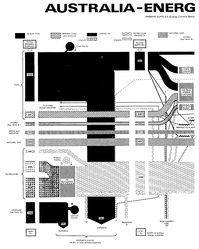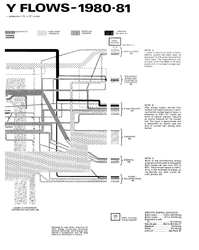


Chapter 11
I The Present Energy Economy
II Australian Energy Consumption
III Research And Development
IV Coal
V Oil And Natural Gas
VI Solar Energy
VII Nuclear Energy
VIII Bagasse Firewood And Other Biomass
IX Electric Power Generation And Distribution electric Power Generation And Distribution
X Manufactured Gas
XI Industrial Process Heat
Sources
Index
Search
Help
Contact us

Our technologically based economy, however, as was pointed out by Sir David Zeidier, sprang from two innovative concepts; the discovery by Michael Faraday of electromagnetic induction in London in 1831, and the development of the joint stock company. Electromagnetic induction is the principle on which all electric generators, motors and transformers are able to operate. It made possible the generation of electricity in large power stations and its distribution to homes and factories. The joint stock company enabled the use of this new form of energy for the rapid development of industrial enterprises, since the risks could be shared and the rewards distributed to a large number of people.
The first use of electricity in Australia, as in most countries, was for street lighting. Between 1888 and 1892 small networks appeared in Tamworth, Young, Penrith, Moss Vale, Broken Hill and Sydney. There is a report of a small generator being installed in Regent Street, Sydney to light the Redfern Rail Terminal in 1882, which was only three years after Edison had invented the incandescent lamp. The prime movers for these early systems were small steam or oil engines.
Public electricity supply was initially developed by local government bodies. This led to the present situation, where each State develops and controls its own system of electricity generation, transmission and distribution, because at Federation in 1901 energy was one of the residual powers retained by the States.
Electricity is, however, a secondary source of energy and needs a heat engine or a water turbine to drive the alternators. The largest primary source of energy for electric power generation is coal, which is also Australia's largest source of energy for all purposes. A very effective way of illustrating the energy economy was developed by Joan C. Miller to show how Australia's various energy sources supply the final users. For 1980-81, Fig. 1 shows how our primary energy sources, black and brown coal, oil and natural gas, wood and bagasse, and hydro electric power, enter the economy on the left of the chart (the width of the bands representing the energy content) and supply the energy users on the right of the chart.

A limited number of the original coloured versions of this diagram is available from the office of the Australian Academy of Technological Sciences and Engineering. These have been kindly supplied by the State Electricity Commission and the Australian National Committee of the World Energy Conference

Oil inputs comprise local and imported crude entering refineries and imported refined products feed directly into the refined stream. Wood, bagasse, natural gas and some coal go straight to the final users on the right of the chart.
The energy input to power stations consists of black and brown coal and a stream shown as the fuel equivalent of the hydro electric output. The total electricity generated is shown as a stream splitting up to supply the end users and represents about 25 per cent of the energy input to the power stations. The 75 per cent balance is shown leaving the chart at the bottom as losses. This is not inefficient, in the sense that the system is poorly designed or operated, but rather is the inescapable consequence of the conversion of heat into mechanical power in the turbines which drive the alternators. There are also losses in electricity transmission and distribution, but they are relatively minor.
People in Bright Sparcs - Miller, Joan C.
 |
Australian Academy of Technological Sciences and Engineering |  |
© 1988 Print Edition pages 780 - 781, Online Edition 2000
Published by Australian Science and Technology Heritage Centre, using the Web Academic Resource Publisher
http://www.austehc.unimelb.edu.au/tia/751.html